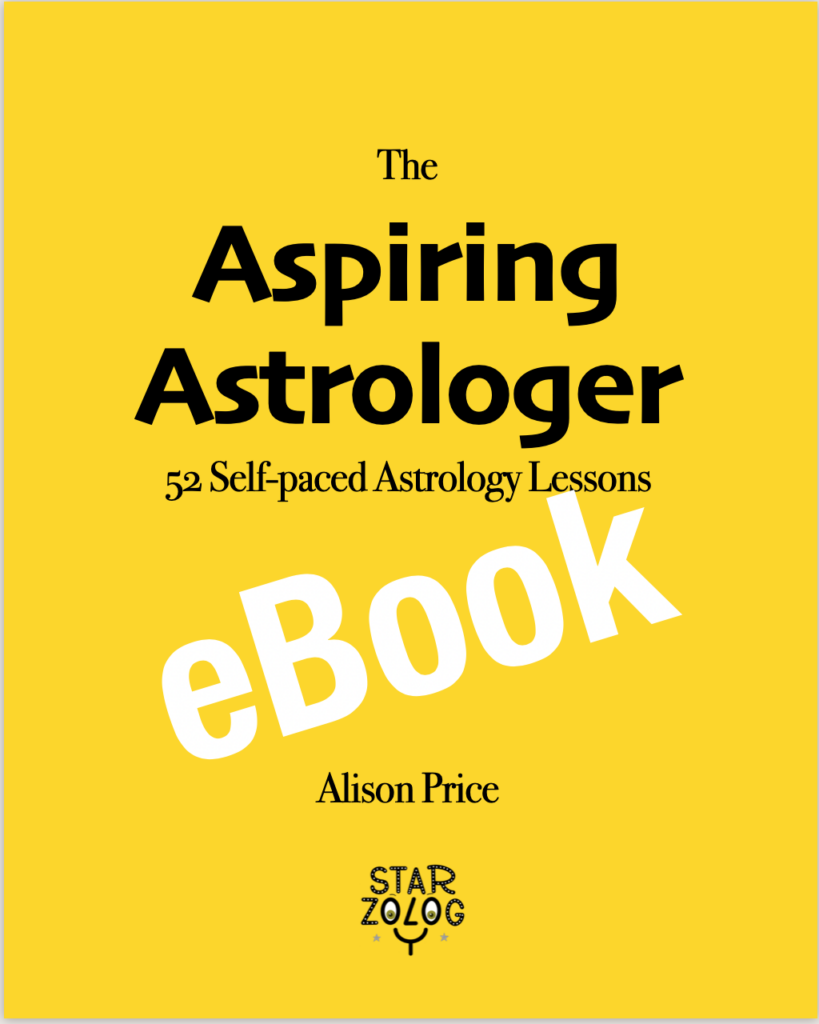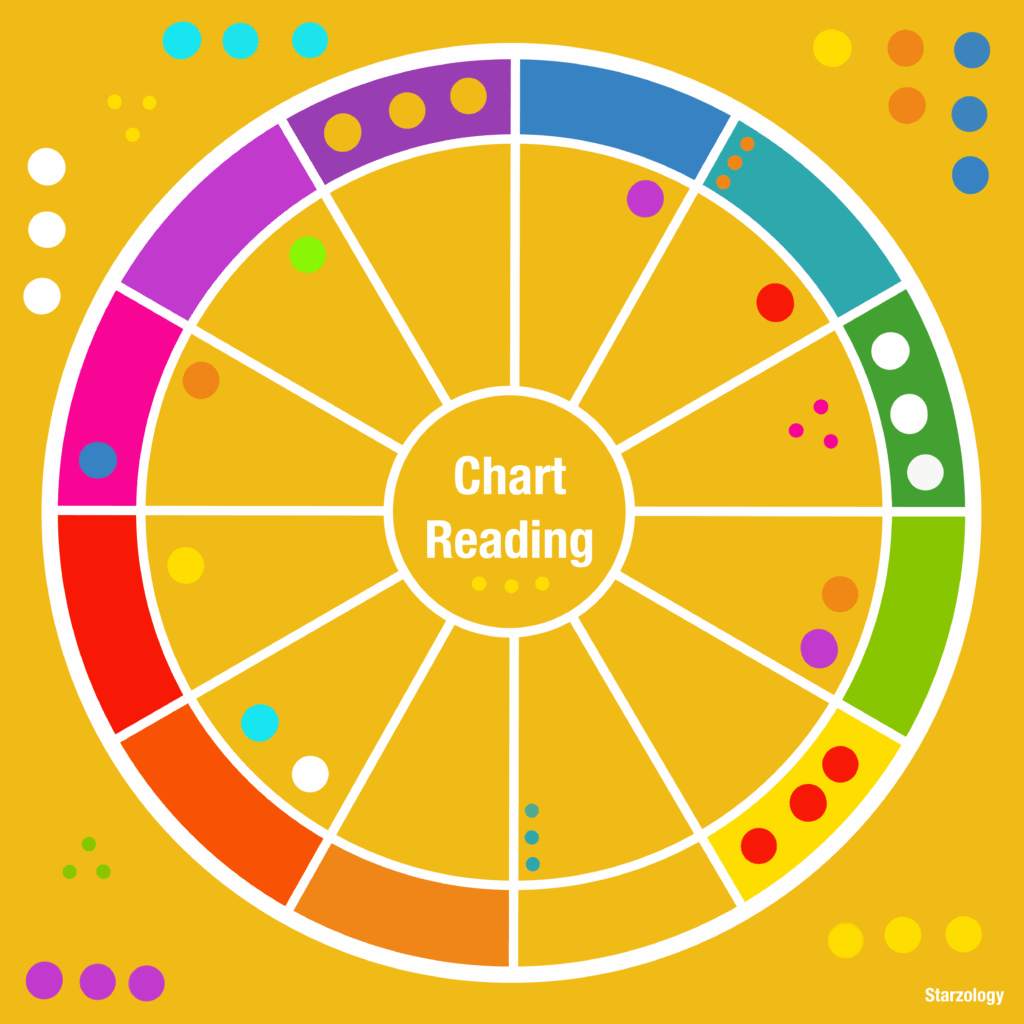The Starzology monthly horoscope overview provides all the ingresses, stations and lunations for each month with a short interpretation.

Forecasting Techniques
Author: Alison Price – Published: July 2024
Forecasting Techniques
Once you can read a chart you’ll want to get into forecasting. Astrology has various techniques to forecast or predict future events and trends. These techniques can be broadly classified into direct and indirect methods. You don’t have to use them all. Here’s a brief overview of the four main forecasting techniques which I use for every chart I interpret.
Podcast Episode
You can listen to the full podcast episode with me and Arwyne by clicking below.
Direct Forecasting Techniques
Transits
Transits involve observing the ongoing movement of planets and how they interact with an individual’s natal chart. As planets transit through the zodiac, they form aspects (such as conjunctions, squares, or trines) with the planets and points in the natal chart. These interactions can indicate significant events, changes, or themes in a person’s life during the period of the transit.
Solar Returns
A solar return chart is cast for the exact moment the Sun returns to its natal position, which happens once a year around your birthday. This chart provides insights into the year ahead, highlighting the major themes, challenges and opportunities. Analyzing the solar return chart in relation to the natal chart can give a comprehensive view of the upcoming year’s potential.

Indirect Forecasting Techniques
Secondary Progressions
Secondary progressions are based on the “day-for-a-year” principle, where each day after birth represents a year in the individual’s life. By advancing the natal chart forward one day for each year of life, astrologers can observe how the progressed planets and points interact with the natal chart. This method reveals the internal, psychological, and developmental changes that occur over time, complementing the external events indicated by transits.
Solar Arc Directions
Solar arc directions involve moving every planet and point in the natal chart forward by the same amount, calculated based on the solar arc (the distance the Sun moves in a day, approximately one degree). This method creates a chart that reflects the evolved positions of the planets and their aspects to the natal chart. Solar arc directions provide a broad, long-term view of life’s significant shifts and transitions.
Other Forecasting Techniques
The following methods are ones which I never use, not because they don’t work, but becasue I prefer the first four methods I mentioned.
Firdaria
Firdaria is a time-lord technique used primarily in traditional astrology. It divides a person’s life into distinct periods governed by different planets. Each planet, known as a “time lord,” presides over a specific phase, influencing the themes and events of that period. The sequence and duration of these periods vary according to the planet’s position and significance in the natal chart.
Profections
Profections is an ancient technique that advances the natal chart one house per year. Starting from the Ascendant, each house represents a year of life, cycling through the entire zodiac every 12 years. The sign and planets ruling the house of the current year become particularly significant, as they highlight the key themes and areas of focus for that year.
Primary Directions
Primary directions involve the symbolic (indirect) movement of planets and points through the sky, representing significant life events and developments. This technique shifts the natal chart forward by a specific amount, usually one degree for each year of life, to see how the planets’ new positions relate to the original chart.
Additional Forecasting Techniques
Here are a few more techniques again that I do not use.
Lunar Returns
Similar to solar returns but focusing on the Moon’s return to its natal position, offering insights into emotional and domestic themes for the month ahead. A lunar return is cast every month this makes it the most short lived method.
Planetary Arcs
Planetary arc directions, are where each planet and point is moved forward by an individual planet’s arc to identify long-term trends and transformations. You choose the planet for the chart by its rulership of the topic in question. For example for the lovelife use a Venus arc chart and for career use a Saturn arc chart This one can be tricky and you may have to do it by hand (without a computer) as not many astrology software programs can calculate other planetary returns although good old Solar Fire does.
Transits to Progressed Chart
Analyzing how current planetary transits interact with the progressed chart is another way to forecast. I’m not sure if this is a viable method becasue you are taking a transit which will be a progression one day, and applying it to an indirect movement of a planet.
Direct Forecasting Techniques
Transits and Solar Returns
The two main direct forecasting techniques I use are transits and solar returns.
Transits: What to Look For
Transits are a key tool in astrology, providing insights into how current planetary movements impact your client’s natal chart. Here’s a quick look at what to consider when interpreting transits:
Planets in Transits
Pluto
Governs transformation, power and regeneration. Pluto transits indicate deep, often intense changes and the need to confront and release what no longer serves.
Neptune
Associated with dreams, intuition, and illusion. Neptune transits can bring inspiration, spiritual growth, but also confusion and deception.
Uranus
Symbolizes change, innovation, and upheaval. Uranus transits bring unexpected events, breakthroughs, breakdownsa and breakouts and shifts in perspective.
Saturn
Represents discipline, structure and challenges. Saturn transits often signify periods of hard work, responsibility and testing.
Jupiter
Brings growth, expansion and opportunities. Jupiter transits indicate times of prosperity, growth, learning and new experiences.
Mars
Drives action, energy and ambition. Mars transits can spark motivation, what you will fight for, conflict and assertiveness.
Venus
Represents love, beauty and harmony. Venus transits influence relationships, aesthetics, money and your social interactions.
Mercury
Governs communication, intellect, trade and travel. Mercury transits affect thinking, opinions, paperwork, information exchange and daily routines.
Aspects
The aspects formed by transiting planets to natal planets and points reveal the nature of the influence.
Conjunctions
Occur when a transiting planet is in the same position as a natal planet. They bring intensified energy and focus on the qualities of the planet involved. Pay close attention to conjunctions, as they signify major periods of activation and focus on the planets involved.
Hard Aspects (Square, Opposition)
Create tension and challenges that often require action and resolution. Squares (90 degrees) and oppositions (180 degrees) indicate conflict, dilemmas, obstacles, or necessary adjustments. Examine squares and oppositions to find areas of conflict, challenge and potential for growth through overcoming difficulties. Many clients arrive in the astrologer’s consulting room when under a hard transit from an out planet.
Soft Aspects
Offer ease and opportunities. Trines (120 degrees) and sextiles (60 degrees) facilitate growth, harmony and beneficial developments. Look for trines and sextiles to find periods of harmony, ease, and natural development, where things tend to flow more smoothly. Personally I don’t bother with the soft aspect transits as they oftne just pass by. Whearas the hard aspects demand attention.
- More on TRANSITS
Forecasting Technique: Graphic Ephemeris
I love working with a graphic ephemeris. It is a bit tricky to read to start with but well worth the effort to learn. The Graphic Ephemeris is a powerful visual tool used by astrologers to track planetary movements and their interactions over time. It give a graphical (visual) representation of the positions of planets and their transits relative to an your natal chart.
Understanding the Graphic Ephemeris
Graphical Representation
Unlike a traditional ephemeris, which lists planetary positions in a tabular format, the Graphic Ephemeris displays these positions on a graph. Time is typically represented along the horizontal axis, while the zodiac degrees or signs are shown on the vertical axis.
Tracking Planetary Movements
The graph plots the daily positions of the planets, allowing you to see at a glance how planets move through the zodiac over days, months, or even years. Being on a one page, it helps you to visualize the dynamic nature of planetary cycles.
Identifying Main Outer Transits
By overlaying the positions of transiting planets with key points in the natal chart (such as Pluto, Neptune and Uranus), the Graphic Ephemeris makes it easy to identify when transiting planets form significant aspects to natal planets.
Using the Graphic Ephemeris
Setting Up the Chart
To use the Graphic Ephemeris, one must first set up the chart for the individual or event in question. This involves plotting the natal chart or any other relevant chart.
Overlaying Transits
Once the natal chart is set, transiting planets are plotted over time. This can be done for specific periods, such as a month, a year, or several years, depending on the scope of the forecast.
Interpreting Patterns and Hot Spots
You then analyze the graph to interpret the patterns. Look for when transiting planets cross important points in the natal chart and form aspects to natal planets. These times are then interpreted for their potential impact based on the nature of the planets and aspects involved.
Eclipses
Eclipses are powerful astronomical events that hold significant astrological meaning. In astrology, eclipses—both solar and lunar—are seen as harbingers of change, transformation, and pivotal shifts. They occur in cycles, typically about every six months, and their influence can be felt for months before and after the event. Here’s a detailed discussion on how eclipses serve as a forecasting tool in astrology:
Types of Eclipses
Solar Eclipses
Occur during a New Moon when the Moon passes between the Earth and the Sun, blocking the Sun’s light. Symbolize new beginnings, fresh starts, and the initiation of significant changes. Can highlight areas of life where new opportunities or challenges will emerge.
Lunar Eclipses
Occur during a Full Moon when the Earth passes between the Sun and the Moon, casting a shadow on the Moon. Represent culmination, closure, and the revelation of hidden truths. Often signal the end of a chapter or the need to release something that no longer serves us.
Astrological Significance of Eclipses
Trigger Points
Eclipses often act as trigger points for significant events and changes, especially when they closely aspect personal planets or critical points (Ascendant, Midheaven) in the natal chart. They can catalyze shifts in areas such as relationships, career, health, and personal development.
Intensity and Unpredictability
The energy of eclipses is intense and can bring sudden, unexpected changes. This makes them powerful times for transformation but also periods of instability and unpredictability.
Long-Term Influence
The effects of an eclipse can unfold over six months to a year, making them useful for long-term forecasting. The themes and events triggered by an eclipse can continue to develop and manifest well beyond the date of the actual event.
How to Use Eclipses in Forecasting
Identifying the House Placement
Determine which house in the natal chart the eclipse falls. This indicates the area of life where changes and significant events are likely to occur. For example, an eclipse in the 10th house might signify major shifts in career or public life, while one in the 4th house could impact home and family matters.
Examining Aspects to Natal Planets
Analyze the aspects the eclipse makes to natal planets. Conjunctions, squares, and oppositions are particularly potent and suggest major turning points. Trines and sextiles, while still significant, tend to facilitate smoother transitions and positive developments.
Consider the Nodal Axis
Eclipses occur near the lunar nodes (North Node and South Node), which represent points of destiny and karmic lessons. Eclipses near the North Node suggest new opportunities and growth, while those near the South Node indicate the need for release and letting go of past patterns.
Reviewing Eclipse Cycles
Eclipses follow an 18.6-year cycle, returning to the same zodiac sign and degree roughly every 19 years. Reviewing past events from the previous cycle can provide insights into the themes that might re-emerge.
- More on ECLIPSES
Solar Returns
Key Elements to Consider
A Solar Return chart is a powerful forecasting tool in astrology, created for the exact moment the Sun returns to its natal position, which occurs annually around your birthday. This chart offers insights into the themes and events that will be significant in the coming year. Here’s a detailed guide on what to look for in a Solar Return chart:
Solar Return Sun’s House
The house in which the Solar Return Sun is placed reveals the main area of focus for the year. Each house represents different aspects of life, and the presence of the Solar Return Sun highlights the significance of that area.
1st House
Personal identity, self-expression, appearance, and new beginnings.
2nd House
Finances, possessions, self-worth, and values.
3rd House
Communication, learning, siblings, and daily interactions.
4th House
Home, family, emotional foundations, and private life.
5th House
Creativity, romance, children, and hobbies.
6th House
Work, health, daily routines, and service.
7th House
Relationships, partnerships, and significant others.
8th House
Shared resources, transformation, intimacy, and deep psychological matters.
9th House
Travel, higher education, philosophy, and belief systems.
10th House
Career, public life, reputation, and ambitions.
11th House
Friendships, social networks, goals, and aspirations.
12th House
Solitude, spirituality, hidden matters, and subconscious.
Solar Return Sun’s Aspects
The aspects the Solar Return Sun makes to other planets in the Solar Return chart provide additional layers of meaning, indicating how the themes of the year will play out.
Conjunctions
Intensify the influence of the involved planets, indicating major focal points.
Squares
Highlight challenges and areas requiring effort and adjustment.
Oppositions
Suggest balancing and integrating opposing forces or perspectives.
Trines and Sextiles
Indicate opportunities, ease, and harmonious developments.
The Solar Return Ascendant in Your Natal Chart
The Ascendant of the Solar Return chart, when compared to the natal chart, provides insights into how the year’s energy will manifest and where personal growth will be emphasized.
Ascendant in 1st House
Focus on self-development, personal goals, and self-image.
Ascendant in 2nd House
Emphasis on financial matters, resources, and personal values.
Ascendant in 3rd House
Increased communication, learning, and interactions with the immediate environment.
Ascendant in 4th House
Home, family dynamics, and emotional security are highlighted.
Ascendant in 5th House
Creativity, romance, and enjoyment take center stage.
Ascendant in 6th House
Health, daily routines, and work are key areas of focus.
Ascendant in 7th House
Partnerships and relationships play a significant role.
Ascendant in 8th House
Deep emotional transformations, shared resources, and intimate relationships are emphasized.
Ascendant in 9th House
Travel, education, and broadening horizons become important.
Ascendant in 10th House
Career and public life are highlighted, with potential for achievements.
Ascendant in 11th House
Friendships, social connections, and long-term goals are emphasized.
Ascendant in 12th House
A year of introspection, spiritual growth, and addressing subconscious issues.
Solar Returns: Additional Considerations
Planetary Emphasis
Note the planets that are prominently placed or heavily aspected in the Solar Return chart, as they will play a crucial role in shaping the year’s experiences.
Lunar Phases
The phase of the Moon at the time of the Solar Return can provide additional insights into the emotional tone and overall mood for the year.
Angle Activation
Pay attention to any planets located on the angles (Ascendant, Midheaven, Descendant, IC) of the Solar Return chart, as they will have a heightened influence.
Repeating Patterns
Compare the Solar Return chart with the natal chart to identify repeating themes or significant transits that may reinforce certain areas of focus.
Extend Yourself: Direct Forecasting
Below are a few questions to ask yourself when starting with forecasting. You will of course go deeper and explore every avenue for your paying clients.
Considering the period of the next 12 months and using an orb of 1° applying and separating, in your astrology journal please do the following:
Transits
- List any outer planet (Uranus, Neptune and Pluto) conjunctions to your natal planets, Ascendant or Midheaven and note the date.
- List any middle planet (Mars, Jupiter and Saturn) changing house and note the date.
- Find the next retrograde periods for Mercury, Venus and Mars and note which natal houses they will be in for you.
- Write one sentence to sum up the transit forecast.
Eclipses
- Note if the next solar eclipse will conjoin any of your planets, Ascendant or Midheaven.
- Note which natal house the next lunar eclipse will be in for you.
Extend Yourself Further: Indirect Forecasting
Below are a few questions to ask yourself when getting greater into forecasting. You will of course go deeper and explore every avenue for your paying clients.
Considering the period of the next 12 months and using an orb of 1°, in your astrology journal please do the following:
Secondary Progressions
- State the progressed chart ruler.
- List all natal retrograde planets that are now direct by progression. If there are any, go back and find the station direct dates.
- List all natal planets that are now retrograde by progression. If there are any, go back and find the station retrograde dates.
- List all progressed planets that will change signs and note the dates.
- List all progressed planets that will change house and note the dates.
- Write one sentence to sum up the secondary progressed forecast.
Solar Arc Directions
- Find any solar arc directed planet conjoined a natal planet, the Ascendant or Midheaven and note the date.
- Find any solar arc directed planet opposing a natal planet, the Ascendant or Midheaven and note the date.
- Find any solar arc directed planet squaring a natal planet, the Ascendant or Midheaven and note the date.
Overall
- Write one sentence to sum up the complete overall forecast.
- Explore all the main themes that have come up through your examination of all the forecasting techniques. Write a brief summary (500 words).

Pin this to read later
Author Bio
Alison Price: Professional Astrologer
Alison helps you uncover your individual creativity and lead a fulfilling life using your own astrology. She shares her wisdom from the heart with a touch of humor. She offers Consultations for everyone and Coaching for Aspiring Astrologers.
If you’d like to get in touch with Alison, you can reach out to her via email at starzology@gmail.com.
More Articles
If you enjoyed this post, you may like some more astrology related articles from our blog.

This Month’s Horoscope Overview

Pluto Aspects
In astrology, PLUTO and his aspects can indicate where serious transformations will occur in your life.Make sure to explore this planet.

This Month’s Horoscope Overview
The Starzology monthly horoscope overview provides all the ingresses, stations and lunations for each month with a short interpretation.

Artists Charts: Venus and Neptune
Author: Alison Price - Updated: March 2025 Artists Charts I'm not just an astrologer, but I consider myself as a hobby artist and crafter as well. Being creative and expressing yourself (and myself) through art is a great interest of mine. Art in a Chart When I...

Sunsetting the Paid Starzlife Newsletter
Sunsetting the Starzlife Paid Newsletter Thursday Edition After nearly a year, I’ve decided to sunset the Starzlife paid newsletter. This means the free Starzology newsletter will continue to go out every Sunday, but the exclusive Thursday edition for paid subscribers...









